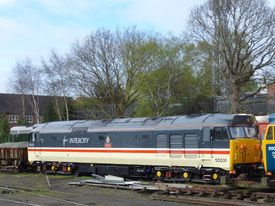BR Class 50 50031 Hood
| BR Class 50 50031 Hood | |
|---|---|
 50031 Hood in 2017 | |
| Built By | English Electric Vulcan Foundry Works, Newton-le-Willows |
| Configuration | Co-Co |
| Power type | Diesel Electric |
| Status | Awaiting overhaul |
| Loco Number | 50031 |
| Other Numbers | D431 |
| History | |
| Built | 1968 |
| Designed By | English Electric |
| Type | Class 50 |
| 1991 | Purchased by The 50 Fund |
| 2007 | Main generator failure |
| 2010 | Returned to service |
| 2016 | Refurbished at RVEL, Derby |
| Technical | |
| Length | 68ft 6" |
| Weight | 115t |
50031 Hood is a BR Class 50 diesel locomotive.
Contents
BR Class 50
Fifty English Electric Type 4 (later BR Class 50) diesel locomotives were built by English Electric at their Vulcan Foundry Works plant in Newton-le-Willows between 1967 and 1968. When built they were numbered in the D4xx series. They later became BR’s Class 50, being allocated TOPS numbers in the 50xxx series. The class was nicknamed “Hoovers” because of the distinctive sound of the inertial air-filters with which the locomotives were originally fitted.
Initially the locomotives were used to haul express passenger trains on the West Coast Main Line (WCML) between Crewe and Scotland; that section not then being electrified. This often entailed ‘Multiple Working’, with two locomotives under control of a single driver.
By 1974 the northern WCML had been electrified, and the Class 50 fleet was being transferred to BR’s Western Region to work main line passenger services out of London Paddington.
The Class 50’s did not originally carry names, but in the late 1970s BR agreed to their being named after Royal Navy vessels with notable records in the First and Second World Wars.
Withdrawal of the class began in the early 1990s.
50031 Hood in service
D431 entered service at Stoke in July 1968, having been built as English Electric Works No 3801/D1172. Less than a year later she was derailed at Lancaster whilst in charge of a parcels train. In May 1973 D431 was transferred to Crewe, being re-numbered 50031 in February 1974. Following electrification of the WCML, 50031 moved to Plymouth Laira, moving again to London’s Old Oak Common in May 1980.
In June 1978, 50031 was named Hood after HMS Hood, the Royal Navy’s last battle cruiser. Commissioned in 1920, HMS Hood was sunk by the German battleship Bismarck on 24 May 1941. 50031 was withdrawn from service by BR on 5th August 1991.
50031 Hood in preservation
50031 was purchased for preservation by two Fifty Fund members in December 1991 in near operational condition, having only minor faults when withdrawn. On the understanding that the 'guide price' was £18000, they simply added the last two digits of the loco's number and bid £18031. They later found out that they had outbid their nearest rival by £31. It moved in March 1992 for initial repairs at St Leonards, '31 then moved to the Severn Valley Railway, arriving 6 May 1994 with 50044 Exeter.[1] It worked the first preserved class 50 hauled train to carry fare paying passengers.
In November 1997 Hood was the first mainline-certified preserved class 50 to haul a main line railtour, “The Pilgrim Hoover” from Birmingham International to Plymouth via the South Devon Banks.
50031 was sent to RVEL, Derby for refurbishment in June 2015. On 11 April 2016, it was revealed in a fictitious BR Inter-City livery, with the locomotive returning to the SVR on 13 April 2016. Following a return to service, the locomotive was re-dedicated in a ceremony at Kidderminster on 17 September 2016. The ceremony marked two anniversaries; 100 years since the keel of HMS Hood was laid in 1916 and 75 years since the ship was sunk during World War 2.
It was withdrawn from service in 2020 pending an engine overhaul.[2] This is not likely to commence until after the completion of BR Class 37 37308[3].
50031 Hood on the main line in preservation
An incomplete list of main line appearances is as follows:
| Date | Tour name | Tour Operator | Route | Notes | Reference |
|---|---|---|---|---|---|
| 16 September 2000 | Celtic Hoover | As D431. With 50049 Defiance | |||
| 27 November 2004 | The Yorkshire Royale | Pathfinder | Cardiff-Derby (detached/reattached)-York (steam) | With 50049 Defiance and 6233 Duchess of Sutherland | [4] |
| 4 March 2005 | The Monarch Of The Glen | Pathfinder | With 50049 Defiance | [4] | |
| 29 May 2005 | The Pixies Revenge | Pathfinder | Banbury to Penzance | With 50049 Defiance | [4] |
| 1 October 2005 | The Devonshire Riviera Express | Steamy Affairs | Northampton to Kingswear | With 50049 Defiance and 60009 Union of South Africa | [4] |
| 25 March 2006 | The Redmire Rambler | Pathfinder | Cardiff to Redmire | With 50049 Defiance | [4] |
| 16-19 June 2006 | The Orcadian | Pathfinder | Swindon to Inverness, Kyle of Lochalsh, Wick and Thurso | With 50049 Defiance | [4] |
| 16 December 2006 | The Airean Raider | Pathfinder | Cardiff to Leeds | With 50049 Defiance | [4] |
Gallery
See also
Diesel Locomotives
List of preservation groups
SVR-based diesel locomotives visiting other events
Locomotives running under different identities
References
Links
Class 50 Alliance web site
50 Fund web site (still maintained)
| ||||||||||||||||||||||||||||||||||||||||||||||||||||||||||||||||||||||||
